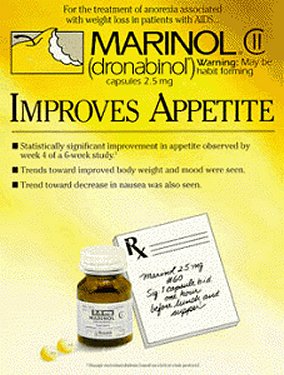 Right: Synthetic cannabinoids are available as prescription drugs in some countries. One example is Marinol, widely prescribed in the USA.
Right: Synthetic cannabinoids are available as prescription drugs in some countries. One example is Marinol, widely prescribed in the USA.
 Found a word you're not familiar with? Double-click that word to bring up a dictionary reference to it. The dictionary page includes an audio sound file with which to actually hear the word said. Found a word you're not familiar with? Double-click that word to bring up a dictionary reference to it. The dictionary page includes an audio sound file with which to actually hear the word said. |
 Background information
Background information
Background
(This material is abbreviated from a Wikipedia entry titled 'medical cannabis'. The full report can be accessed at https://en.wikipedia.org/wiki/Medical_cannabis)
Medical marijuana (cannabis) refers to the parts of the herb cannabis used as a physician-recommended form of medicine or herbal therapy, or to synthetic forms of specific cannabinoids such as THC (delta-9-tetrahydrocannabinol) as a physician-recommended form of medicine.
The Cannabis plant has a long history of use as medicine, with legendary evidence dating back to the fictional Shen Nung in 2737 BCE. Cannabis is one of the 50 'fundamental' herbs of traditional Chinese medicine, and is prescribed for a broad range of indications.
Extent of use
Medical cannabis is illegal in most countries. A number of governments, including the United States Federal Government, allow treatment with one or more specific low doses of synthetic cannabinoids for one or more disorders. However, public opinion in several areas, including the United States, is swinging in favour of use of medical cannabis, especially for chronically ill patients. The topic is one of great controversy and is being debated more than ever.
Studies have shown cannabis does have several well-documented beneficial effects. Among these are: the amelioration of nausea and vomiting, stimulation of hunger in chemotherapy and AIDS patients, lowered intraocular eye pressure (shown to be effective for treating glaucoma), as well as gastrointestinal illness. It also has antibacterial effects and is one of the best known expectorants.
There are several methods for administration of dosage, including vaporizing or smoking dried buds, drinking, or eating extracts, and taking capsules. The comparable efficacy of these methods was the subject of an investigative study conducted by the National Institutes of Health.
Synthetic cannabinoids are available as prescription drugs in some countries. Examples are Marinol (The United States and Canada) and Cesamet (Canada, Mexico, the United Kingdom, and the United States).
While utilizing cannabis for recreational purposes is illegal in many parts of the world, many countries are beginning to entertain varying levels of decriminalisation for medical usage, including Canada, Austria, Germany, Switzerland, the Netherlands, Czech Republic, Spain, Israel, Italy, Finland, and Portugal. In the United States, federal law outlaws all use of herb parts from Cannabis; States that have approved use of medical cannabis are in conflict with federal law. The United States Supreme Court has ruled in United States v. Oakland Cannabis Buyers' Coop and Gonzales v. Raich that the federal government has a right to regulate and criminalize cannabis, even for medical purposes. A person can therefore be prosecuted for a cannabis-related crime even if it is legal medical use according to state laws. The United States federal government, through the National Institute on Drug Abuse (NIDA), continues to provide medical cannabis to four patients who participated in the Compassionate Investigational New Drug Program. NIDA claims this is done for "compassionate purposes" and the United States federal government still maintains that medical marijuana is not an effective or desirable treatment for any medical condition despite significant contrary evidence.
Clinical applications
A 2002 review of medical literature by Franjo Grotenhermen states that medical cannabis has established effects in the treatment of nausea, vomiting, premenstrual syndrome, unintentional weight loss, insomnia, and lack of appetite. Other "relatively well-confirmed" effects were in the treatment of "spasticity, painful conditions, especially neurogenic pain, movement disorders, asthma, [and] glaucoma".
Preliminary findings indicate that cannabis-based drugs could prove useful in treating adrenal disease, inflammatory bowel disease, migraines, fibromyalgia, and related conditions.
Medical cannabis has also been found to relieve certain symptoms of multiple sclerosis and spinal cord injuries by exhibiting antispasmodic and muscle-relaxant properties as well as stimulating appetite.
Other studies state that cannabis or cannabinoids may be useful in treating alcohol abuse, amyotrophic lateral sclerosis, collagen-induced arthritis, asthma, atherosclerosis, bipolar disorder, colorectal cancer, HIV-Associated Sensory Neuropathy, depression, dystonia, epilepsy, digestive diseases, gliomas, hepatitis C, Huntington's disease, leukemia, skin tumours, methicillin-resistant Staphylococcus aureus (MRSA), Parkinson's disease, pruritus, posttraumatic stress disorder (PTSD), psoriasis, sickle-cell disease, sleep apnoea, and anorexia nervosa. Controlled research on treating Tourette syndrome with a synthetic version of THC called (Marinol), showed the patients taking the pill had a beneficial response without serious adverse effects; other studies have shown that cannabis "has no effects on tics and increases the individual's inner tension". Case reports found that cannabis helped reduce tics, but validation of these results requires longer, controlled studies on larger samples.
A study done by Craig Reinarman surveyed people in California who used cannabis found they did so for many reasons. Reported uses were for pain relief, muscle spasms, headaches, anxiety, nausea, vomiting, depression, cramps, panic attacks, diarrhoea, and itching. Others used cannabis to improve sleep, relaxation, appetite, concentration or focus, and energy. Some patients used it to prevent medication side effects, anger, involuntary movements, and seizures, while others used it as a substitute for other prescription medications and alcohol.
